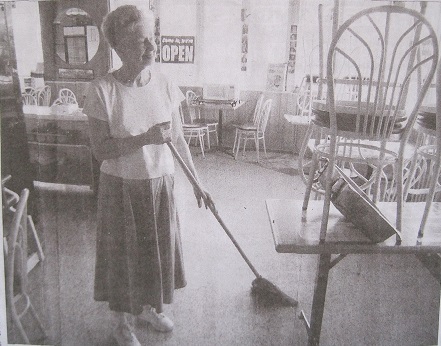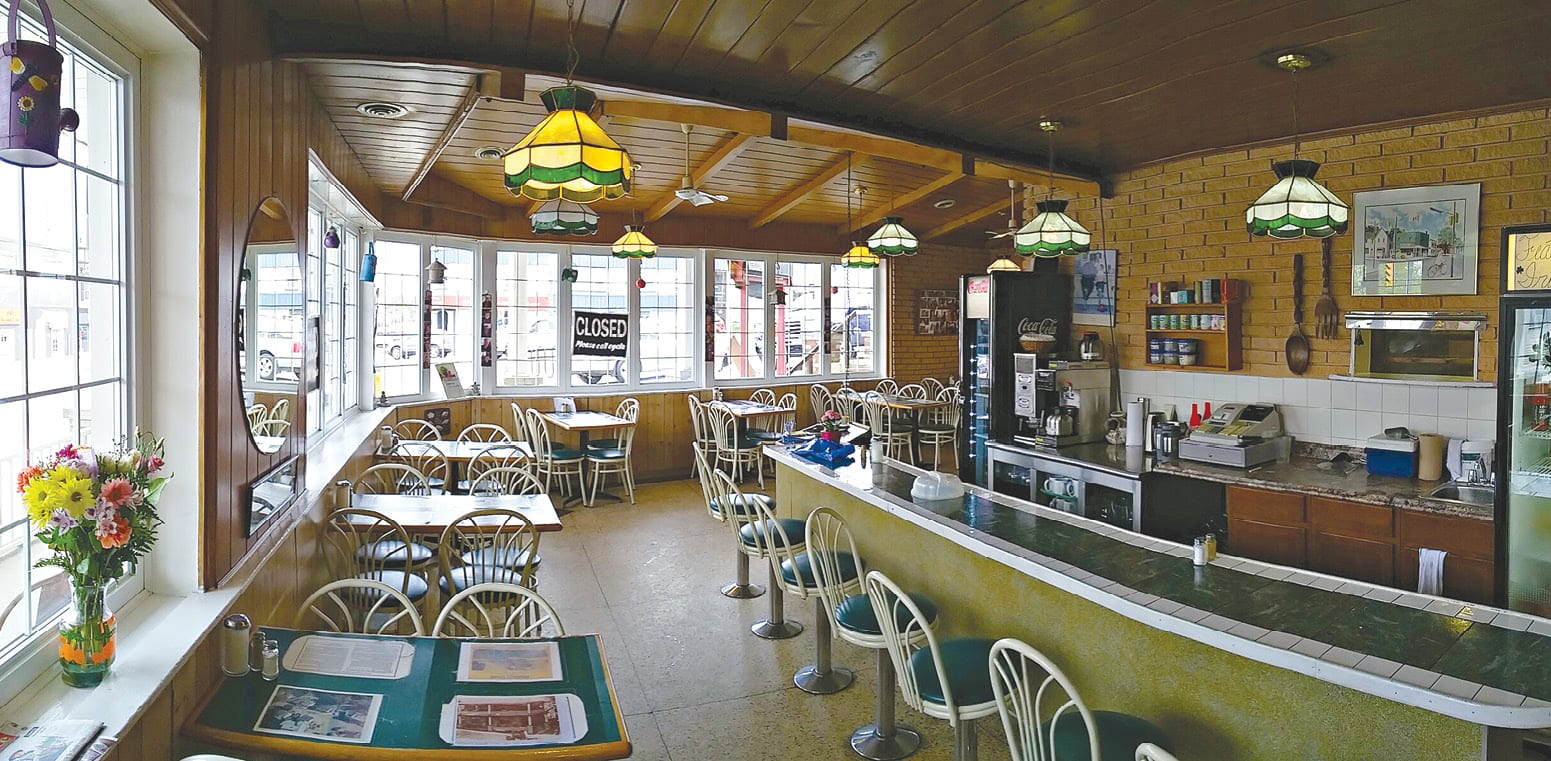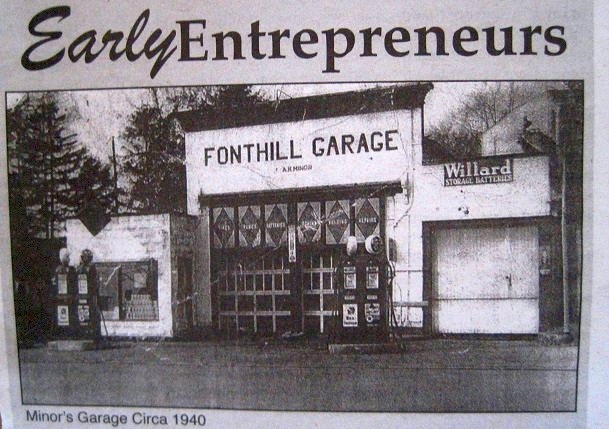Results for ‘Businesses’
Keith’s Restaurant closes its doors after more than 60 years
By Steve Henschel, Photo: Staff Photo
[Niagara this Week, 25 May 2017]
PELHAM-Looking out the windows of Keith’s restaurant Vilma Moretti has watched Fonthill’s continuous march through the decades.
 She was just 18 when she started serving at the eatery, famed for its pies, on the corner of Highway 20 and Pelham Street. The restaurant has been central to her life, she married Keith Crick in 1962, and has run the restaurant along with her son Tom Crick since Keith’s passing in 1993. Now, at age 73, and with the death of her son Tom, the restaurant has closed. On a Friday evening the restaurant’s guests enjoyed a meal and one last slice of pie, before Moretti closed the doors on the location that has sat at the very heart of Fonthill since 1959. No longer will she look out the windows and witness the ever-changing face of the town.
She was just 18 when she started serving at the eatery, famed for its pies, on the corner of Highway 20 and Pelham Street. The restaurant has been central to her life, she married Keith Crick in 1962, and has run the restaurant along with her son Tom Crick since Keith’s passing in 1993. Now, at age 73, and with the death of her son Tom, the restaurant has closed. On a Friday evening the restaurant’s guests enjoyed a meal and one last slice of pie, before Moretti closed the doors on the location that has sat at the very heart of Fonthill since 1959. No longer will she look out the windows and witness the ever-changing face of the town.
“I don’t know where I am sometimes,” said Moretti, who has watched big box stores move into the town. She said it seems sometimes the small town she grew up in is long gone. Klager’s Meats, where Keith’s used to get its meats is closed now, so is Keiths.
“It’s time for me to retire,” said Moretti, explaining with the loss of her son and business partner to pancreatic cancer she can’t keep the restaurant open.
“I still see Tom coming through the doors,” said Moretti, speaking from the shuttered restaurant where the chairs now sit upturned on the tables.
“He’ll always be here,” she said, explaining it is hard to close the restaurant. She added, however, that the memories of that place she will carry forever.
“This place is bricks and mortar, the memories are here, and here,” she said, first pointing to her heart, and then her head. On a physical level those memories live in the more than 300 photos of customers Moretti has been picking up over the last week.
“I’ve been on this corner since I was 18, it’s not been only work, but my social life,” said Moretti.

Keith first moved into the location back in 1959, continuing his foray into the restaurant business after operating the Drift In next door for several years. Before he took over the building it had been a confectionary and then a bakery since first being built in 1929. Keith was born on a farm where he learned to cook from his mother. He brought that talent, and her recipes, to the restaurant business where he, and eventually Moretti and Tom, kept a focus on using top-notch ingredients and made-from-scratch recipes cooked daily.
“He certainly could bake pies,” said Moretti, adding, “Tom took after him in that respect.
Moretti met Keith, 26 years her senior, when she took on a serving position after graduating from Pelham High School. He was a friendly man, she recalled, young at heart who loved to golf, play bridge and talk politics.
“He was a charmer,” she said.
Moretti explained it is the people she will miss the most.
“My customers as well as my staff are my family,” she said, adding some of her wit staffers have been working tables for over two decades.”
Moretti said Keith’s is home for many of the staff, patron and herself.
“That is what this place is, everybody comes home to Keith’s,” said Moretti, who is putting the location up for sale. She hopes that perhaps another restauranteur with a focus on home cooking could open up shop.
*Personal note. I cannot stress enough how wonderful this spot was for everyone in the village. Not only the pies were amazing, but the roast beef was worth the trip to Keiths.’
[Evening Tribune, 31 October 1964]
Sausages and apples predominated the Welland market this morning. Some varieties of sausages though appearing exotic to English Canadian patrons, are actually commonplace to their fellow countrymen from Central and Easter Europe.
Two varieties of blood sausage, for example, one lighter in color than the other, sold at 35 cents a pound. French sausage was 59 cents a pound and Polish sausage went at 65 cents a pound. Two more familiar kinds, farmers sausage and liver sausage, sold at 59 and 55 cents a pound respectively.
A great profusion of apples in many varieties met the eye of incoming customers. Spies were there, selling at 65 to 85 cents a six-quart basket. The Courtland type, especially held away, selling at 75 a six quart basket. Red delicious were 85 cents a six-quart and MacIntosh were 70 cent a six-quart basket. Pears sold at 65 cents a six-quart basket.
Egg prices were as follows: small, 35 cents, medium, 45 cents, large, 53 cents extra-large, 55 cents.
Beef heart sold at 35 cents a pound, baby beef liver at 49 cents and geese and ducks, 59 cents a pound.
One standout, a booth selling nothing but chrysanthemums, attracted many buyers. Its mums went from $1 to $1.25 a bunch.
Vegetable prices were as follows: squash, 10 to 25 cents apiece; pumpkins, 20 to 50 cents apiece; potatoes, 50 cents a six quart basket; cauliflower two for 25 cents; cabbage 20 cents a head; garlic 35 cents a pint and $2.75 a six-quart basket; red peppers, 25 cents a pint; Spanish onions 75 cents a six-quart basket.
Affixing Stamps in the Proper Corner Assists Work at the Post Office
[Welland Tribune, February 1929]
 For more than 10 months, Welland postoffice has had in operation a stamping machine attached to which is an electric meter.
For more than 10 months, Welland postoffice has had in operation a stamping machine attached to which is an electric meter.
During these 10 months a million letters have gone through this machine, not including large size envelopes of letters posted with stamps in other than the right-hand corner.
Postoffice officials explained that the rapidity of movement in the work of stamping letters by the machine was badly hindered at times by the practice on the part of some correspondents of affixing the regular stamps on any place but the proper right-hand corner.
Officials stated that the machine was of exceptional service at such times as Christmas, Easter, St. Valentines’ Day and similar heavy mail delivery periods, and similar heavy mail delivery periods, and the St. Valentine’s Day mail delivery service had been the heaviest known.
Merchants down town bore this last statement out. One firm alone sent out over the Niagara peninsula no less than 43,200 one-cent valentines, more than 10,000 valentine cards, and between 4,000 and 4,500 10 cent-cards, to say nothing of thousands of post cards.
Cheese Factory Sold-Will Be Turned Into A Creamery
[People’s Press, 17 October 1905]
Welland cheese factory at Welland Station has been sold by Mr. McGregor to the Pure Milk Corporation of Hamilton, who will convert it into a first class creamery. An up-to-date plant will be put into the creamery, the cost of which, with other improvements, will amount to several thousands of dollars. The cream will be used for butter in the winter time, and shipped to the cities for the manufacture of ice cream in the summer time.
The creamery will make a fine market for cream all throughout this section of country.
BUILDING TO BE USED AS CAR WRECKING SHOP BY NEW OWNER-MEET IN RENOVATED CHAMBER
[Welland-Port Colborne Evening Tribune, 9 March 1940]
The old packing house on Seventh street, which reverted to Crowland township several years ago for back taxes was taken over by Stanley Reid, when the township council accepted an offer of $2,000 for the property. The original cost of the building was $40,000.
From the time that the packing plant business, founded by a group headed by the late Frank Ahman, went into bankruptcy the building deteriorated rapidly and will require a considerable expenditure for repairs. The new owner will use the building for a car wrecking establishment.
The township council had for several years made attempts to dispose of the building without success, although last year machinery in the plant was sold. In accepting the offer of Mr. Reid, which included only the land on which the building stands, the view that it would be preferable to dispose of the property and collect taxes than to let the building deteriorate further. Not included in the purchase price was land to the east on which stand some garage buildings, and land to the west for which the council had on past occasions received offers as building lots.
IN RENOVATED QUARTERS
The council met last night in the newly decorated chambers which has been vastly improved in appearance by the laying of a green and red linoleum, and the whole effect is modernistic in tone and highly effective from a decorative stand point. Venetian blinds on the large front windows of the building adds to the effect. Council members commented most favorably on the improved appearance of the chamber, which is also used as a courtroom. The redecorations extend to the clerk’s office and the office of the police chief. Cost of the work was approximately $500.
Council appointed C.R. Hagey, Fort Erie as township engineer, replacing J.R. Scott, who had advised council that his duties as county engineer prevented him for accepting any other commissions. The newly appointed engineer will begin his duties next week in connection with the proposed watermain and sewer on Wallace avenue north. Two more lots were sold on the street at last night’s meeting to bring to 15 the number of prospective homes to be built on the street this summer.
Coun il accepted the tender of Angelo Addario for supplying crushed stone from the township-leased stone quarry in Humberstone. Mr. Addario’s tender was $1.17 per yard delivered on township roads. Tenders for other materials were opened. But action was deferred.
Welland-Port Colborne Evening Tribune
9 March 1940
Modest Beginning To be Made With Prospects Of Enlarging.
ON BURGAR STREET
[Welland Tribune, 16 March 1940]
The establishment in Welland of a shoe manufacturing concern was announced today by T.J. Darby, K.C., of behalf the Welland Shoe Co., formed recently to manufacture children’s shoes and sandals. The new industry is the first of its kind to late in the city.
The company was formed by Steve Krnjaich and Joseph Yeszam of Humberstone, both of whom have considerable experience in the manufacture of shoes, and were until recently connected with the Erie Shoe Co., of Humberstone. The latter is a co-operative enterprise promoted by Mr. Krnjaich which in a year’s time has grown from a concern employing eight persons to the employing 35 at the present time.
The Welland Shoe Company recently completed the purchase from the Griffiths Estate of a brick warehouse at 198 Burgar street, which was formerly occupied by National Grocers, and it is expected that full operations will begin by the first of April. Machinery is now being installed.
The factory will begin operations with 10 employees, but according to Mr. Krnjaich a considerably greater number will be employed when operations are fully under way. The building is sufficiently large to house machinery to occupy 100 employees. Including a basement and two floors, the structure is 80 feet long by 40 feet wide.
The firm has orders available at the present time. Mr. Krnjaich was optimistic concerning future expansion. “With the present demand of shoes, particularly for the export market, I anticipate that it will not be long before we will have to increase our staff,” he said.
Mr. Krnjaich has had 30 year of experience in the show business, first in Jugoslavia whence he came to Canada 12 years ago and later at Humberstone. His partner, Mr. Yeszam has been connected with the industry for 12 years
By Mary Lamb
[The Voice, 10 June 2009]

In Pelham, in the early 1900s, transportation was by horse and wagon or buggy. The roads were mostly unpaved. If you could afford a car, and they were beyond the means of the average family, the speed limit was 20 M.P.H., and you had to give way to horses. In the village of Fonthill there were four cars in 1918, and that was when Herbert Minor opened his garage. At the time it must have looked like a risky venture, but it paid off and the garage didn’t cease pumping gas until 1984.
Herbert Minor grew up on a farm, but he became interested in automobile engines and in 1910 passed his mechanic’s test. When he moved to Fonthill, the old registry office, built by Dexter D’Everado in the 1850s, was empty and unused. Mr. Minor decided to buy it and open it as a garage business, selling gas and servicing cars. He also provided a towing service for cars which broke down or got stuck in the Pelham’s roads. When the village fire service was organized, Herbert Minor was appointed chief, and the hand-drawn fire truck was kept next to the garage. Mr. Minor served as fire chief for 18 years.
When the time came for him to retire, Herbert Minor passed the business on to his son, Austin, who later took on his son, Wilfred, as a partner. Although the garage was sold to Cliff Moffat in the 1960s, the Minor family connection with Steve Milnor, Wilfred’s son working there as a mechanic. Herbert Minor’s risky enterprise lasted for 66 years.
*I took my car to Minor’s garage in the 70s and always found Cliff to be an excellent mechanic. Always felt confident he would see that my car left the garage in great condition.
[Welland-Port Colborne Evening Tribune, 23 January 1947]
It is a credit to the Welland County General hospital that it has gained provisional approval in the listings of the American College of Surgeons for 1946. Each year the listings contain hospitals in the United States and Canada which have compiled satisfactorily with the fundamental requirements that assure the best care of the sick and injured.
Provisional approval indicates a hospital which is trying to meet the requirements of the college, but for acceptable reasons has not been able to do so in every regard.
The hospitals of both countries are reconsidered each year, and as wartime difficulties have disappeared the standards are higher. In 1946, 3,118 hospitals qualified-a decline of 63 from the year before.
Dr. Irvin Abell, president of the college’s board of regents, explained this as a “sinking into post-war lethargy”. He said the college expected hospitals to be “leaders in the post-war effort to improve every type of welfare service.”
The citizens of a community are held responsible for insisting upon good hospital service and for giving the support and encouragement need to provide it. The two problems now facing hospitals are inadequate nursing staffs and untrained administrators.
The College of Surgeons appeals to schools and community institutions to stimulate recruiting of student nurses. It suggests that the public can see that hospital administrators appointed are men who understand both the professional and business problems of a hospital.
Niagara peninsula hospitals did well in the ratings. Fully approved were the Niagara Peninsula Sanatorium and St. Catharines General hospital. The Niagara Falls hospital was provisionally approved.
The requirements for approval include the following fundamentals: modern physical plant, clearly defined organization, carefully selected governing board, competent, well-trained superintendent, adequate and efficient personnel, organized medical staff, adequate diagnostic and therapeutic facilities, accurate and complete medical reports for research, regular group conferences of the administrative and medical staffs, and a humanitarian spirit-“the primary consideration being the best care of the patient.”
Newest Addition Will Be In Corrugated Steel; Lean-to Planned
READY IN MARCH
[Welland-Port Colborne Evening Tribune, 1 February 1940]
Foundation pillars have already been laid for the erection of a new corrugated steel sheeting warehouse and lean-to on East Main street for Atlas Steels Limited, according to plant officials. The new building will be completed toward the end of March, and will cost approximately $18,000. It will be on similar lines to the rolling mills for which a building permit was issued in December to the value of $14, 675.
Standard Steel Construction Company Limited of Port Robinson will have the contract. The building will have a frontage on East Main street of 100 feet with a depth of 157 feet, it was learned.
This is to be a storage building and will not involve any additions to the payroll, The Tribune was informed. The warehouse will be 80 feet frontage, with a depth of 157 feet, and the lean-to will have a frontage of 20 feet and a depth of 157 feet.
[Welland Tribune, 27 August 1897]
DUNNVILLE knocks Welland out on electric light prices. The electric light plant there is run by a private company, and run right up to date. An all night service is given the year round, and consumers can have a single light for seven cents a week; over ten lights, six cents per week each; and over twenty lights, five cents per light per week. The electric light station is a fine brick structure set on massive stone walls-a credit to the place. Messrs. Haskins & Ralston are the owners, and when asked if there was any money in it at these figures, cautiously and smilingly remarked that they managed to pay their way and have a little pin money to the good. The company have between 800 and 900 lights, and their machines have a capacity of about 1500. Incandescents are being tried at certain points along the main streets and give a promise of working well.
 She was just 18 when she started serving at the eatery, famed for its pies, on the corner of Highway 20 and Pelham Street. The restaurant has been central to her life, she married Keith Crick in 1962, and has run the restaurant along with her son Tom Crick since Keith’s passing in 1993. Now, at age 73, and with the death of her son Tom, the restaurant has closed. On a Friday evening the restaurant’s guests enjoyed a meal and one last slice of pie, before Moretti closed the doors on the location that has sat at the very heart of Fonthill since 1959. No longer will she look out the windows and witness the ever-changing face of the town.
She was just 18 when she started serving at the eatery, famed for its pies, on the corner of Highway 20 and Pelham Street. The restaurant has been central to her life, she married Keith Crick in 1962, and has run the restaurant along with her son Tom Crick since Keith’s passing in 1993. Now, at age 73, and with the death of her son Tom, the restaurant has closed. On a Friday evening the restaurant’s guests enjoyed a meal and one last slice of pie, before Moretti closed the doors on the location that has sat at the very heart of Fonthill since 1959. No longer will she look out the windows and witness the ever-changing face of the town.
 Subscribe..
Subscribe..
 For more than 10 months, Welland postoffice has had in operation a stamping machine attached to which is an electric meter.
For more than 10 months, Welland postoffice has had in operation a stamping machine attached to which is an electric meter.